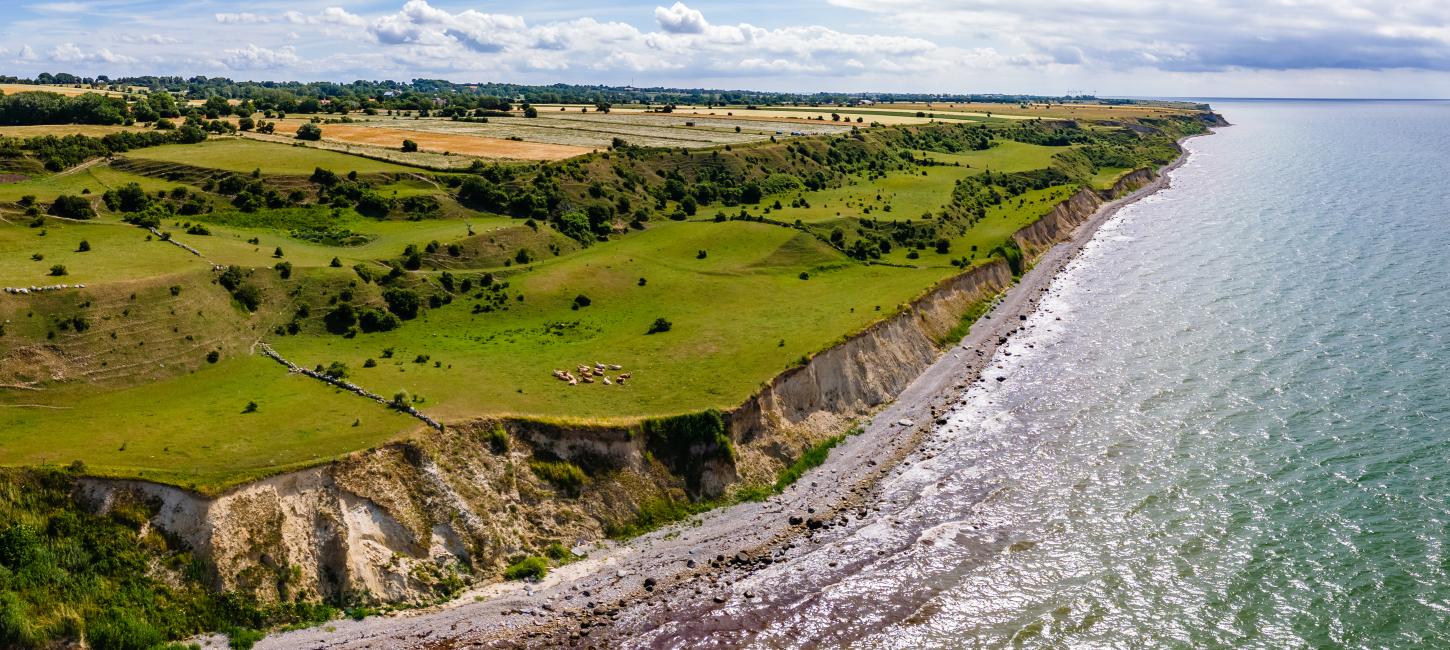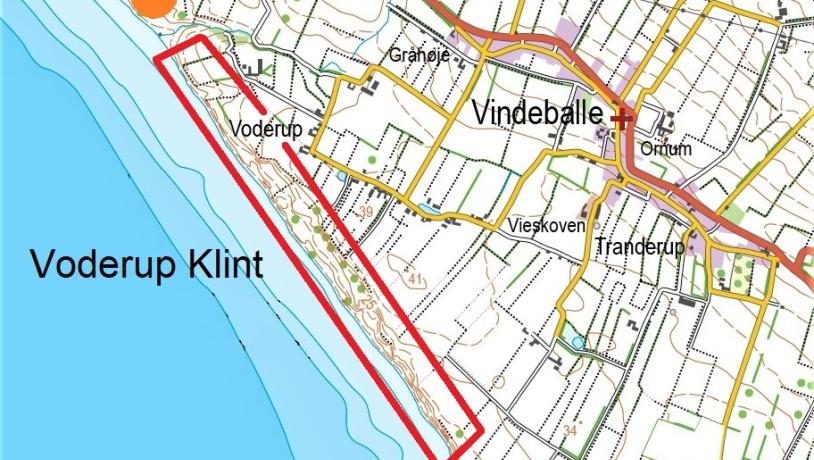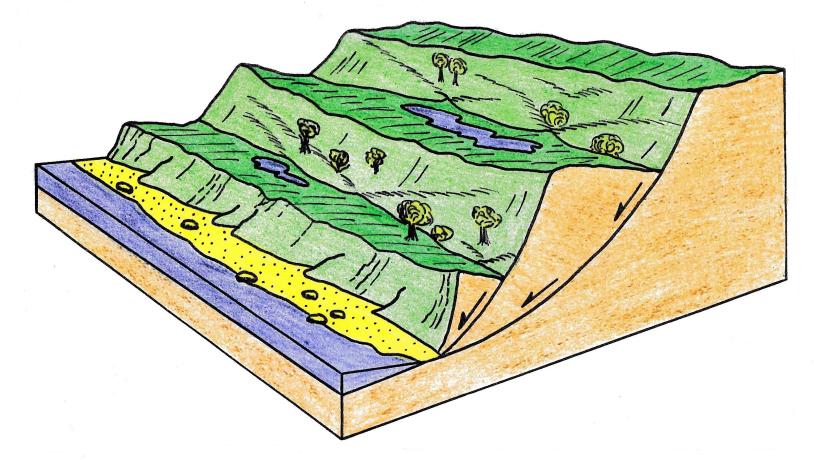
Voderup Klint (Voderup Cliff)
Experience the largest natural steps in the geopark: the landslide terraces at Voderup Klint.
The impressive and picturesque landscape at Voderup Klint, 2.5 km southwest of Vindeballe, is one of Ærø's most visited natural attractions. Voderup Klint is approx. 3 km long and 25-33 m high and forms part of an almost unbroken line of cliffs that stretches along most of Ærø's south coast.
The area was protected in 1957 and is managed by the Danish Nature Agency. It is easily accessible all year round from the large parking lot above the cliff, where there are also toilet facilities and information boards. From here, a footpath with stairs leads to the beach, while another path runs along the top of the landslide terraces with great views along the way.
The cliff is located in one of the southernmost areas of the country and the climate is therefore relatively mild. The southwest-facing slopes with grasslands have a special microclimate that creates good conditions for various reptile species and a number of rare insects and plants. In the small ponds created by springs at the foot of the 'steps', you may be lucky enough to hear the characteristic croaking of the bell frog in late spring.

Photo:Illustration: Søren Skibsted.
The ice age landscape at Voderup Klint
The layer series in Voderup Klint appears to be largely the same as in Ristinge Klint on Langeland. The oldest layers are 'The Shiny Clay' and shell-bearing, sea-deposited 'Cyprina Clay' from the Eemian interglacial (130-115,000 years before present). This is followed by the 'White Sand', deposited by wind and water in an Arctic climate characterized by permafrost prior to the Ristinge Thrust (55-50,000 years ago) in the Weichselian. The younger deposits consist of moraine clay and meltwater sand deposited by the 'Northeast Ice Age' (23-21,000 years ago) and the two Young Baltic ice advances (19-17,000 years ago). In some places, there are also alternating dark clay and sand layers of uncertain age, which do not occur in Ristinge Klint.
The hinterland of Voderup Klint consists of a moraine surface with low elongated hills (so-called drumlins), which the youngest ice streams have 'pulled out' in a southeast-northwest direction.
The main attraction of the cliffs, however, are the characteristic landslide terraces that resemble giant steps. They were created when rainwater seeping down through the soil layers meets fat, water-leveling clay layers from the Eemian interglacial period. Here, the water and the fatty clay form a kind of slide, on top of which the overlying soil layers slide out as large, elongated blocks along curved sliding surfaces. As they slide, the blocks rotate on their own longitudinal axis parallel to the coast, causing the surface of each block to slope slightly inwards towards the land. This type of slide is called a rotational slide. At the base of each 'step', seeping groundwater has collected on the surface of the sloping blocks, creating small moist depressions and water holes for amphibians and aquatic plants.
A little northwest of the cliff was Bregninge Brickworks. Built in 1888, it had its own jetty and employed 10-12 workers. A coal-fired ring kiln was added in 1908. However, due to a fairly high lime content in the clay, the bricks were of mediocre quality. After production ceased in 1938, the buildings were demolished and today only the chimney remains.
The dynamic coastal landscape
After the sea invaded the area south of Funen in the Holocene (the period after the last ice age) and created the South Funen Archipelago, the constant wear and tear of the sea on the glacial landscape has created striking cliffs along the southern coast of Ærø. The entire stretch along Voderup Klint has developed as a steep coastline with a rectilinear course. The beach is narrow and rocky with scattered large boulders that the sea has washed out of the cliff. Storms and high tides during the winter months often create large shore walls of pebbles along the foot of the cliff, which for a time provide some protection against erosion by the sea.

Photo:Illustration: Søren Skibsted. Efter Larsen (2002).
The landscape in the future
From a geological perspective, the glacial landscape in the cliff hinterland is unlikely to change in the foreseeable future. Apart from the human impact on the surface terrain, e.g. through normal agricultural operations, changes to the landscape are expected to be limited. However, the landscape will lose character through afforestation, the establishment of large solar cell installations and the installation of wind turbines as part of the green transition.
With the prospect of an expected rise in sea level and climate change, which is expected to increase the frequency of storms and high water situations, coastal degradation is likely to accelerate.
Two types of erosion are distinguished: (1) Chronic erosion, which is the daily wave, current and wind impact on the coast; (2) Acute erosion, which typically occurs during storms in combination with high tides and strong wave action. Severe acute erosion of cliffs, especially during storm surges, can cause landslides and loss of land. Similarly, increased precipitation will increase the risk of landslides.
In 2020, GEUS scaled up monitoring of coastal land areas where potentially destructive landslides can threaten buildings and/or important infrastructure. This monitoring also includes several stretches along the south coast of Ærø, including the Voderup Klint area. According to local sources, the last very large landslide occurred in 1834, while the last major landslide in recent times occurred in the 1980s. Thus, the landslide processes still seem to be periodically active and most landslides usually occur in years with particularly high precipitation. Due to Ærø's geological conditions, where many of the cliffs contain highly disturbed layers of fat clay (primarily 'Det Blanke Ler' and 'Cyprina Ler' from the Eemian interglacial), some coastal areas must be considered particularly prone to landslides.
However, as part of the preservation of the geopark's natural characteristics and geodiversity, the cliffs should be kept free from coastal protection as far as possible, so that the natural coastal processes can continue to operate freely while keeping the illustrative geological profiles open.
A rising sea level will potentially increase the risk of saltwater intrusion into coastal drinking water wells and/or aquifers.
Due to the morphology and formation history of the area, the surrounding moraine landscape contains relatively few depressions with small areas of moss and low-lying soils. However, increased precipitation together with rising sea levels can affect groundwater levels and runoff conditions and locally raise water levels, potentially causing problems for properties and farmland in the area.
As the terrain slopes are relatively moderate and the surface soils are predominantly clayey, more frequent cloudbursts are unlikely to lead to significant changes in surface erosion. Most of the landscape in the hinterland is cultivated. Increased precipitation also influences the natural soil-forming processes and could, for example, lead to increased leaching of clay, salts, minerals and nutrients from the upper soil layers.
Value
Voderup Klint is an area of national geological interest with great research, teaching and communication value for studies of landslide mechanisms in Danish Quaternary deposits. Furthermore, the area has a high aesthetic value and is one of the most visited natural attractions on Ærø.
The microclimate on the dry and warm, southwest-facing slopes and terraces creates favorable living conditions for several reptile species and specially adapted plant communities, and the small isolated wetlands are important biotopes for amphibians and aquatic plants.
The area was protected in 1957 and is managed by the Danish Nature Agency. It is protected under Natura 2000 site no. 127 and Habitat area H111. The area is classified as part of the National Geological Interest Area NGI 130 and part of the National Coastal Interest Area NK 43.
Longitude: 10.334943
Latitude: 54.866214